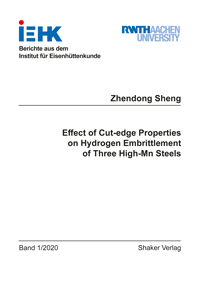
Shop : Details
Shop
Details
45,80 €ISBN 978-3-8440-7156-6Softcover122 pages71 figures171 g21 x 14,8 cmEnglishThesis
January 2020
Zhendong Sheng
Effect of Cut-edge Properties on Hydrogen Embrittlement of Three High-Mn Steels
This study aims to fill a knowledge gap about the cutting effect on hydrogen embrittlement behavior of three different high manganese steels (HMnS). Slow strain rate tests are carried out on uncharged and hydrogen-charged specimens which were processed by four cutting technologies: electrical discharge machining, laser cutting, abrasive waterjet cutting, and blanking. Detailed investigations of the cut-edge quality in terms of microstructure and mechanical properties elucidated the cutting influences on hydrogen-influenced fracture in HMnS.
Electrical discharge machining and laser cutting belong to thermal cutting which have limited influences on the initial microstructure and produce a relatively smooth cut-edge. Both abrasive waterjet cutting and blanking involve plastic deformation, but blanking generates a significant hardening effect with microvoids and distorted grains in the shear-affected zone (SAZ). Due to these factors, the blanked specimens show the worst tensile ductility regardless of hydrogen charging. Conversely, without edge hardening, the thermal-cut specimens exhibit less sensitivity to hydrogen embrittlement. The SAZ of the blanked specimens behaves as a pre-crack effect during tension, which is facilitated by the deformation twin.
Electrical discharge machining and laser cutting belong to thermal cutting which have limited influences on the initial microstructure and produce a relatively smooth cut-edge. Both abrasive waterjet cutting and blanking involve plastic deformation, but blanking generates a significant hardening effect with microvoids and distorted grains in the shear-affected zone (SAZ). Due to these factors, the blanked specimens show the worst tensile ductility regardless of hydrogen charging. Conversely, without edge hardening, the thermal-cut specimens exhibit less sensitivity to hydrogen embrittlement. The SAZ of the blanked specimens behaves as a pre-crack effect during tension, which is facilitated by the deformation twin.
Keywords: Cutting; Hydrogen Embrittlement; Tensile Behavior; TWIP
Berichte aus dem Institut für Eisenhüttenkunde
Edited by Prof. Dr.-Ing. W. Bleck, Prof. Dr.-Ing. U. Krupp, Prof. Dr.-Ing. S. Münstermann and Prof. Dr.-Ing. D. Senk, Aachen
Volume 2020,1
Export of bibliographic data
Shaker Verlag GmbH
Am Langen Graben 15a
52353 Düren
Germany
Am Langen Graben 15a
52353 Düren
Germany
Mon. - Thurs. 8:00 a.m. to 4:00 p.m.
Fri. 8:00 a.m. to 3:00 p.m.
Fri. 8:00 a.m. to 3:00 p.m.
Contact us. We will be happy to help you.



